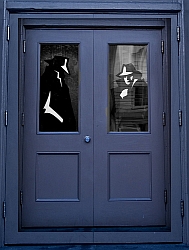 The phone rings late one evening. You answer it to hear the voice of a woman in distress: ‘I can’t keep this up any longer, they’re getting too close to the truth!’. She hangs up suddenly, but not before leaving you with a cryptic clue – a password to some online network that she had managed to get a hold of. Your next move, should you choose to take it, is to log onto that network and download the encrypted data hidden within.
The phone rings late one evening. You answer it to hear the voice of a woman in distress: ‘I can’t keep this up any longer, they’re getting too close to the truth!’. She hangs up suddenly, but not before leaving you with a cryptic clue – a password to some online network that she had managed to get a hold of. Your next move, should you choose to take it, is to log onto that network and download the encrypted data hidden within.
But did you cover your tracks with an appropriate proxy, or just leave your home IP address open for the investigators to find you? Unfortunately you didn’t cover your tracks well enough, and you receive a message to your Facebook account from a Russian femme-fatale asking you to return the data immediately or face the consequences. You smile with glee at this latest twist in the world of subterfuge you are experiencing. Because, you see, this isn’t an experience with real-life consequences of jail terms or physical danger – this is the world of Alternate Reality Gaming.
Alternate Reality Gaming is a phenomena that has been around in one form or another for the better part of 15 years. The concept is remarkably simple, and yet impossible to pin down – an experience that transcends one single medium, blurring the lines between reality and fiction and in the best of cases leaving you questioning your own actions, motivations, and perception of everyday life.
Alternate Reality Games (ARGs) run the whole gamut from corporate marketing exercises; to intricate science-fiction delivered over multiple formats; to initiation-like experiences intended to have an impact on the very core of your being. For the most part they are entertainment, but entertainment in which all of those participating have made a mutual pact to pretend that it is real and to act accordingly.
Emerging predominately out of the mid-1990s, ARGs are about to reach a new crescendo of popularity and public recognition. With the emergence of social media ubiquity, the ARG experience has been enhanced quite considerably; and as we approach a more mainstream acceptance of technology such as augmented reality the possibilities for this reality-blurring form of entertainment are quite staggering. Pretty soon the line between what is physically real and what is part of the collective hive consciousness will become so fuzzy that the time will be perfect for these all-encompassing entertainment experiences.
 Where previously those running an ARG might be cheeky enough to put up a few graffiti stencils on a tube station to help bring the game into your world; or direct you to meet a shady stranger in a car park who gives you your next clue; now they will be able to quite literally paint an alternate reality over the top of the world you see around you. A world only available to those participating in the experience, whereby through the use of your camera phone (or, in the more distant future, your augmented glasses) you will have access to a living and breathing conspiracy theory, murder mystery, or other such game of urban cat-and-mouse.
Where previously those running an ARG might be cheeky enough to put up a few graffiti stencils on a tube station to help bring the game into your world; or direct you to meet a shady stranger in a car park who gives you your next clue; now they will be able to quite literally paint an alternate reality over the top of the world you see around you. A world only available to those participating in the experience, whereby through the use of your camera phone (or, in the more distant future, your augmented glasses) you will have access to a living and breathing conspiracy theory, murder mystery, or other such game of urban cat-and-mouse.
To be honest, I can’t wait – and it is something that I’ve started looking into in much more depth recently as I really do believe it will become a major form of emergent entertainment over the coming decades. With this enthusiasm, however, also comes some very serious reservations (this is Future Conscience after-all!). Serious enough that I think it is worth discussing very openly, and hopefully some active members of the ARG community will drop by and leave some thoughts to help enlighten us. The reservations I have primarily revolve around two things: police intervention and the possibility of gross (and possibly militant/violent) participant manipulation.
Let me give an example to help you see where I am coming from. In Melbourne, Australia about 5 or 6 years ago there appeared a number of billboards that simply stated ‘Get Out of Your Mind’. That was it, no further information other than a website address. Upon further investigation, there was some kind of registration process – but one that did not indicate in any manner just what you were signing up for. It turns out that Neurocam was a kind of hybrid ARG, art-project and spiritual experiment.
 The whole purpose of it was to feel like you had joined a mysterious and secret organisation, an organisation which instructed you to perform various operations and report back to them. It was a fascinating concept, and it certainly proved popular (if you do a Google search for ‘Neurocam’ you will find the remnants of debate about just what, exactly, this whole thing was). There was even an article written up in a major Australian newspaper at the time.
The whole purpose of it was to feel like you had joined a mysterious and secret organisation, an organisation which instructed you to perform various operations and report back to them. It was a fascinating concept, and it certainly proved popular (if you do a Google search for ‘Neurocam’ you will find the remnants of debate about just what, exactly, this whole thing was). There was even an article written up in a major Australian newspaper at the time.
Even to this day, it is not 100% clear who formed Neurocam (some shady entity known only as The Nautionier); what exactly it’s goals where; and whether or not it even continues to exist today. As an art project, it was pure brilliance. As an ARG, it perfectly blurred the line between fiction and reality. As a spiritual/philosophical exercise, it certainly got a lot of people ‘out of their minds’ to an extent – although ultimately failed to truly deliver on its promise. As a social experiment in obedience, it scares the living heck out of me.
Why would such a thing be cause for concern? Well, in one of the early operations the so-called ‘agent’ would receive an email communication directing them to conduct surveillance on the public at a designated area and send the detailed report of all movements back to an unknown entity. In others, they were asked to carry mysterious small packages to dead-drop locations – safes hidden away and buried in public parks or other such places.
The whole purpose was to become part of an experience in which your normal frames of reference no longer applied; one in which you had no relevant cultural norms to rely upon and instead exist within a newly created paradigm in which the present was more important than anything else. From a close examination, it seems that the final fate of Neurocam was because of a failure of leadership – organisers eventually lost interest, and the second/third generation leaders were unable to continue with such enthusiasm or succumbed to the ravages of in-fighting and the lack of real credit since all involved at the top needed to remain anonymous. But just consider the possibilities of such an exercise if done for nefarious purposes…
Because, you see, the agents did their operations. Many of them with great enthusiasm and without question. Some of them, even, clearly hoping that Neurocam actually was a real organisation (and indeed in many ways it was) with genuine secrets and hidden agendas. Most of these people were involved in something fun, something that brought a sense of risk and excitement to their otherwise mundane lives.
For many people, being involved with something that evades definition like Neurocam will forever be a pivotal moment in the development of their personalities. Neurocam became about more than the participants, more than the organisers – it became a living, breathing entity of its own with shifting agendas and structure. Indeed, this was the whole purpose of the experiment all along. Neurocam was Neurocam, nothing else could define it.
But let’s not beat around the bush any longer. For there are definite areas that should raise cause for concern in this social experiment.
 Willingly picking up unmarked packages and delivering them to public areas is an incredibly easy way to become an unknowing drug mule – or, even worse, a ‘suicide bomber’. Conducting surveillance for an unknown entity would be the perfect ruse for a government or militant organisation to collect intelligence. Being given a password to an unknown FTP site and downloading the information there could set you up as the perfect cyber-patsy…all in the name of entertainment.
Willingly picking up unmarked packages and delivering them to public areas is an incredibly easy way to become an unknowing drug mule – or, even worse, a ‘suicide bomber’. Conducting surveillance for an unknown entity would be the perfect ruse for a government or militant organisation to collect intelligence. Being given a password to an unknown FTP site and downloading the information there could set you up as the perfect cyber-patsy…all in the name of entertainment.
It might sound a bit paranoid, and indeed it is. But what I want to highlight is that Alternate Reality Games are the perfect framework for unscrupulous organisations to take advantage of willing participants – those who want to be a part of the next James Bond movie, science fiction epic, or noir murder mystery; but only if, when all is said and done, it is inherently a fictional experience. The problem comes from the mutual creation of a suspension of disbelief – that ‘bomb’ you are trying to disarm isn’t really a ‘bomb’; the ‘secret message’ you are delivering isn’t actually of any importance to the government; the person you are ‘stalking’ actually is in on the game and in the end just playing a role.
For the vast majority of these types of things – indeed, from what can be gathered, all of them thus far – it is a brilliant and truly genius way to blur the line between reality and fiction. To make us question the paradigms we view the world with and show us a glimpse of a more exciting, illuminating, adrenaline-filled lifestyle. But Neurocam is an example of where the line has already blurred between whether or not this is purely entertainment or a much deeper and all-encompassing experience. The scary thing was, that there were a lot of people out there who would have done pretty much anything they were told – just to get a little bit deeper down the rabbit hole.
Even without evil puppet-masters, in our increasingly security conscious world it’s only a matter of time before somebody gets brought up on public surveillance charges or some other form of police-state heavy-handedness.
I’m being overly paranoid, I realise that. But all I’m saying is that it’s a possibility; and because it’s a possibility we have to take it very seriously indeed. However, Alternate Reality Gaming is a truly new form of entertainment – one to be enjoyed by those who like to challenge their perception of reality and everyday life. Just be careful who you trust…




